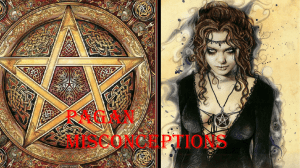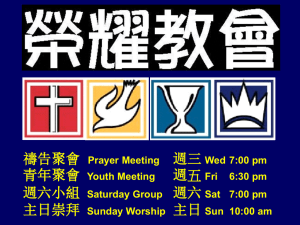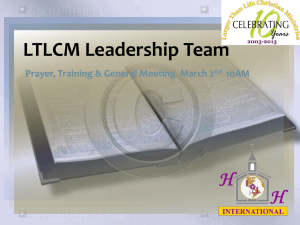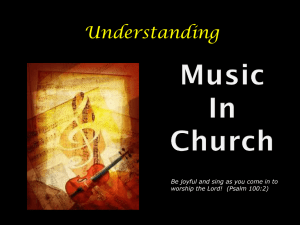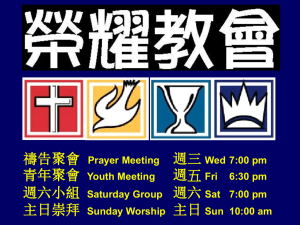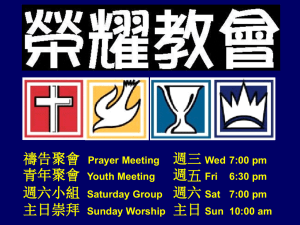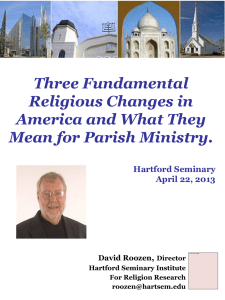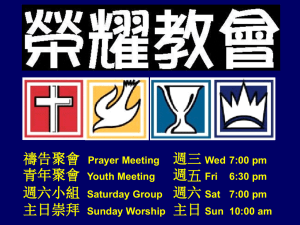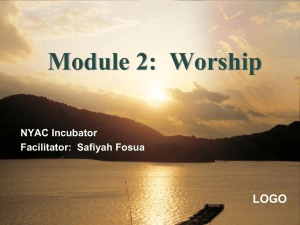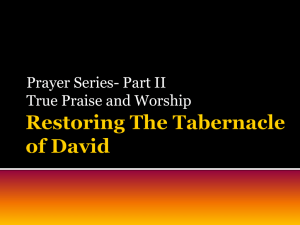PowerPoint - Trinity Evangelical Lutheran Church
advertisement
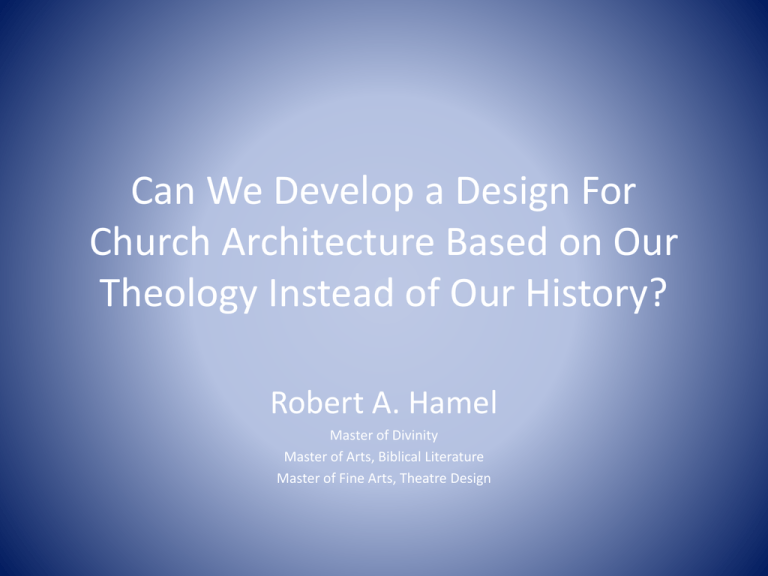
Can We Develop a Design For Church Architecture Based on Our Theology Instead of Our History? Robert A. Hamel Master of Divinity Master of Arts, Biblical Literature Master of Fine Arts, Theatre Design “To Boldly Go Where No One’s Gone Before” Though We’ve Been Trying for Decades! And Have Kept on Trying The Evangelical Lutheran Worship includes; - Ten musical settings of the liturgy for the Holy Communion Service, three of which were previously published in the Lutheran Book of Worship - Service of the Word. Morning Prayer (Matins), Evening Prayer (Vespers), and Night Prayer (Compline) - Occasional and pastoral offices such as baptism, marriage, burial, individual confession - Proper services for Ash Wednesday, Palm Sunday, and the Triduum - Martin Luther’s Small Catechism - Unlike the abbreviated Psalter included in the Lutheran Book of Worship, ELW includes the entire Book of Psalms in a version for congregational prayer and singing. - Compared to the Lutheran Book of Worship, the selection of hymns is expanded, including many options from previously published Lutheran hymnals and hymnal supplements. And still we struggle with issues related to the environment of our primary worship life. And almost every ELCA congregation still worships in spaces that look like this. Obviously there are significant challenges. - Sanctuaries represent major resource investment. - Remodeling requires even more investment. - There is very little awareness how our environments control our worship life. - There is very little awareness how our theology is in conflict with our architecture. - Our past decisions have all too often been based on what our history tells us church architecture should look like. 4th Century Synagogue in Capernaum Built over 1st Century Synagogue 1st Century Synagogue preserved underneath. What does this environment say to us? Intimate, People Centric, (People see one another as the gathered Israel), Grounded in God’s Creation, Horizontal Axis emphasized. Dura-Europas House Church Oldest evidence of how 1st Century Christians worshiped; Intimate, People Centric, Flexible, Grounded, At Home with your Brothers and Sisters. Different Spaces used for: Gathering, Preaching/Teaching the Word, Holy Communion, and Holy Baptism. The Worship Leaders are Amongst the People at all times. The Primary axis of emphasis continues to be horizontal. Jesus Stills the Storm Jesus Heals the Paralytic The Artist has an important role in proclamation of the Gospel story. Interestingly, this is also the time in the life of the church when the New Testament stories and sayings of Jesus, and the Letters of Paul are being collected into Holy Scripture. Worship life is sensual; a banquet of color and contrast, filled with aroma and texture, (note the ointment jar in the nitch), and built of natural elements. How the Greco-Roman world envisioned Church (Temple) Pagan Temple Worship • Pagan Temples were for the Priests. • There were no congregations connected to Pagan Temples. • People brought grain and animals for sacrifice either to appease angry Gods or to get the Gods on their side, Priests feasted on the offerings. • That was what pagan worship amounted to. Occasionally wealthy patrons would offer sacrifice and hold a banquet with their friends to enjoy the feast. • Buildings were valued for their outside appearance. Only Priests saw the inside. • The Primary Axis of focus is Vertical, reflecting a theological role for the temple to be that “in-between” space between earth bound humanity and the Gods who primarily existed above the world. • Christianity did not replace Paganism. They were in serious decline long before Jesus was born. A few pagan temples managed to hang on well into the 10th Century. It all changes with Emperor Constatine. This is the ancient Roman Basilica in Trier, France. Emperor Constatine; -made Christianity a state sponsored religion, -built free Basilica buildings for Christianity all over the empire, -then made the church the center of civil law and judgment. Basilicas are architecture purposely all about power and who does and does not have it. It does so by having; -immensely tall structures that belittle the size of the human figure, -extremely long distances from entrance to the area of judgment, -elevated area in the front upon which the Priest stood to pass judgement. The Church most graciously accepted the Imperial favor, the glorious buildings, the civic responsibility, and the law and judgment based theology the Basilica proclaimed. After all; - God is the greatest conceivable being of all, and deserves such immensely tall and glorious buildings. - God is the final judge and the highest authority, all should approach in abject humility. - The human person is a slimy worm, totally depraved, and may come into God’s presence only by divine summons. - The Priest is not like the normal person but is the worthy perfection of what humanity is intended to be. He is therefore rightly elevated above the unworthy people. - There is no distinction between sacred and secular. As a representative of the Emperor, the priest unifies the will of the state with the will of God. - What the Priest does in celebrating the Mass is done on behalf of the people but does not require their presence. They do not need to even understand the language. Therefore it is better to put distance between the sinful people and the holy altar of God. - As these Basilicas became wealthy, Pews were introduced for congregational sitting. They also imposed orderly rows of regimentation upon the congregation and emphasized formality in worship. Roman Basilicas become the preferred design for church and Roman Mausoleums become preferred designs for Baptistries. BASILICA OF ST MARY, MINNEAPOLIS AND THIS ARCHITECTURAL STYLE STILL DOMINATES CHURCH ARCHITECTURE TODAY IN ALMOST EVERY CHURCH IN EUROPE AND NORTH AMERICA. The Basilica Style did develop two variations in the Middle Ages, both were cross shaped expansions of the older Basilica style. This is the Cathedral of Pisa, Italy which follows the form of the Latin/Roman Cross. And the Byzantine or Eastern Orthodox Cross Style. Above left is in Athens, Greece, and the above is in Russia. Hagia Sophia (Holy Wisdom) in Istanbul, Turkey was designed to be the perfect example of this eastern style with its cruciform ground plan and grand celestial dome. So what was gained and what was lost in this first official style of Church Architecture? Gained –buildings which emphasized; -God in his heaven, the Great Judge of the World -a separation between the priest and the people -an elevation of the clergy over the people -orderliness and control over people’s activity -clear and strong connection between church and the state -clear authority of the church over both spiritual and civil life -altar table becomes tomb where Christ’s body and blood are entombed between services. Saints relics entombed in the altar. This model well suited the church up to the Reformation. Lost –buildings which emphasized; -God present amongst the people -a unity of the people with their clergy -flexibility, adaptability, informality But the Reformation fixed all that medieval error, right? You’d like to think so, but…… Nothing reformed architecturally, just the same old history carried over by both Lutherans, Calvinists and Anglicans. And they all made things even worse. The centrality of Preaching led to immense, elevated Pulpits and small Baptismal Fonts and Communion Tables that could be moved out of the way when not needed. The Preaching service became what church was all about. And the place and role for the artists was reduced to music only. Calvinists broke out stained glass windows. Mennonites threw out the church organs and pianos in favor of brass instruments. And many Protestants rejected the rich heritage of the visual artist in painting, vestments, sculpture, etc. as being “too Catholic.” Worship environments became sterile and plain. Nothing should visually distract from the “hearing of the Word.” What Happened in Our Own Country? Earliest structures sought to reproduced what they knew from the Old World. Spanish Mission Style -San Xavier del Bac Tucson, Arizona And Our Own Mission Santa Barbara But in New England a new style of church architecture emerged for the first time in over 1000 years. The style retained the elevated Pulpit, small Communion Table and Baptismal Font of its Calvinist old world predecessors. But the building is intimate, people centered and only tall enough to permit a surround balcony for overflow seating. Separate doors seating for separate sexes were actually a theological development in the style. BROADHOUSE OR MEETINGHOUSE OLD SHIP MEETING HOUSE, MASS. This form was common among early Lutheran Church buildings as well. Augustus Lutheran, Trappe PA, 1748 Built by Henry Melchoir Muhlenburg Old St Paul’s, Newton, North Carolina Barratt’s Chapel, Frederica, Delaware, 1780 Jerusalem Lutheran, New Ebenezer, GA. 1769 Old Brick, St Paul’s Episcopal, Smithfield, Virginia, 1732 Only Gothic Church Building in The United States. But the interior of the building reflects the Meeting House style. Although the exterior is long and Basilica in shape, with a massive Gothic tower, notice how the building is used. The elevated Pulpit is positioned along one side of the building instead of in a Chancel area at one end. People sit in a U shaped arrangement of pews, centered around the Pulpit. Baptismal Font is located in its own corner of the room. Altar/Communion Table is at the end of the building opposite the tower entrance. After the Revolutionary War, American Church Architecture returned to the European Basilica model. Several new external design forms developed but all are Basilica in form. Neo-Classical Georgian Romantic, Gothic Revival Neo-Classical Federal Romantic, Medieval Revival Romantic, Greek Revival Romantic, Prairie Gothic Romantic, Carpenter Gothic Romantic, Spanish Revival Romantic, Timbered Gothic AND THEN SOMETHING NEW DEVELOPED, AUDITORIUM STYLE The Great Awakening revival so focused on preaching that a new architecture emerged. All across the country a style developed that built on the extreme production values of the revivalism of the day. Slanted audience seating curving around the raised Preacher/Choir/Organ platform. An altar call ideal. Auditorium Plan Note the fan shaped layout, the curved, elevated three-quarter round seating on both the main floor and balcony. Note also the center front “staging” area for the Preaching, Testimony, Teaching, and Music. See the very small portable Communion Table and no Baptismal Font at all. Adult conversion is the norm. Richardsonian Romanesque develops in partnership with the phenomenal surge in Sunday attendance to hear the Great Preachers and their musical Soloists and Choirs following the Civil War. This is the era of George Whitefield, Samuel Davies, The Rev. Billy Sunday, Norman Vincent Peale, Bishop Fulton J. Sheen, and The Rev. Billy Graham. Presbyterians, United Methodists, Baptists and the whole spectrum of Evangelicals enthusiastically embraced this new style. This is the second moment in America when historical antecedents were set aside because of theological needs. The first was Puritan Meeting House. SO, WHERE ARE WE TODAY? The vast majority of congregations still worship in Basilica floor plan churches. The majority of the rest of the congregations worship in Auditorium floor plan churches. But there is a new phenomenon of churches being built and or renovated to create worship spaces that better unite our theology with our architecture. The congregations seek to return to the earliest priorities of the first centers of Christian Worship, the House Church. They seek to; -restore the importance of the horizontal, people to people focus, -restore the maximum of flexibility within the worship space, -restore the four-fold equality of focus between the place of the word (Pulpit or Ambo), the place of the meal and prayer(Communion Table), the place of the water, confession, and entrance rites (Baptismal Font), and the place of the people (Body of Christ), -the return of the full range of artistic involvement in worship life, -the return to natural, light filled environment, nothing artificial, -the return to hard surfaces that enhance the acoustics of the room (no “sound sucking” carpeting). The Grandeur of height can be refocused from its historic origins in power, intimidation and judgment to proclamation, welcome and Grace! Organ Pipes which need the height to do their job of proclamation and worship leadership, are perfect for those high ceilinged chancel areas. But note how the organ is not the focus of the room, the light, warm woods of the Altar, kneeling railings and seating bring the human eye away from the metallic pipes to the more human and welcoming place of the people. And just look at that Baptismal Font! OK, let’s take a closing look at Fonts. Ancient Baptismal Font Hagia Sophia, Istanbul New Font designs focus on the primacy of The Means of Grace –Water, moving, living, Spirit filled water, and the ability to practice emersion as well as pouring or sprinkling. These are MAJOR centers of worship at the entrance to buildings. Of course we must not take this moving water thing too far. Toyota powered Baptismal Fonts are probably not a good idea. On that note I wish you blessed reflection on our Theology of Worship and your worship space.
